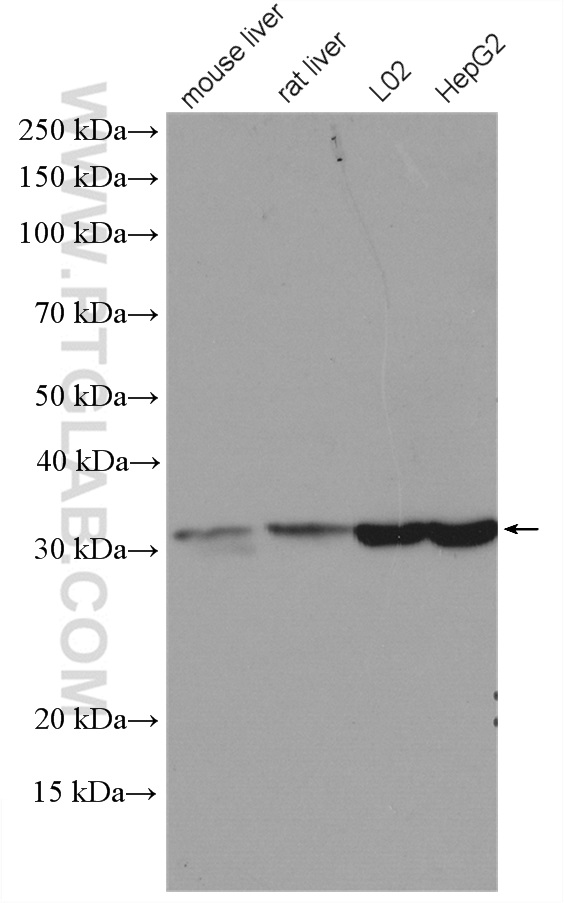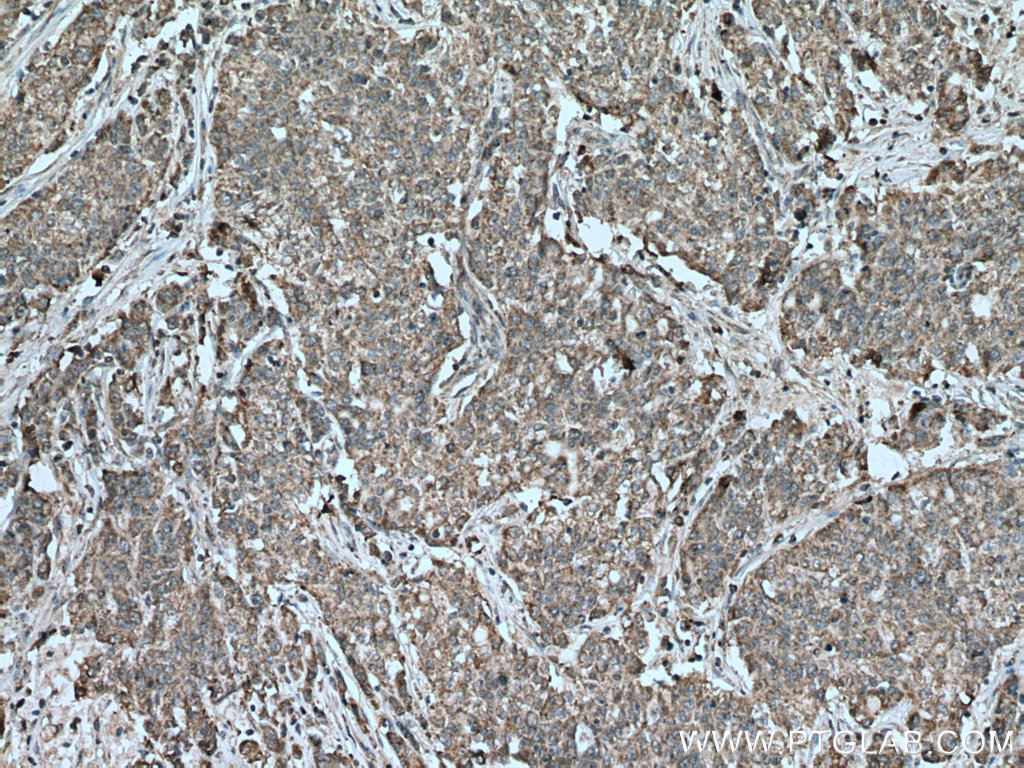验证数据展示
经过测试的应用
| Positive WB detected in | mouse liver tissue, L02 cells, HepG2 cells, rat liver tissue |
| Positive IHC detected in | human liver cancer tissue, human stomach cancer tissue Note: suggested antigen retrieval with TE buffer pH 9.0; (*) Alternatively, antigen retrieval may be performed with citrate buffer pH 6.0 |
推荐稀释比
| 应用 | 推荐稀释比 |
|---|---|
| Western Blot (WB) | WB : 1:500-1:3000 |
| Immunohistochemistry (IHC) | IHC : 1:400-1:1600 |
| It is recommended that this reagent should be titrated in each testing system to obtain optimal results. | |
| Sample-dependent, Check data in validation data gallery. | |
产品信息
27592-1-AP targets RACK1; GNB2L1 in WB, IHC, IF, IP, CoIP, RIP, ELISA applications and shows reactivity with Human, mouse, rat samples.
| 经测试应用 | WB, IHC, ELISA Application Description |
| 文献引用应用 | WB, IF, IP, CoIP, RIP |
| 经测试反应性 | Human, mouse, rat |
| 文献引用反应性 | human, mouse, pig, monkey |
| 免疫原 | RACK1; GNB2L1 fusion protein Ag26708 种属同源性预测 |
| 宿主/亚型 | Rabbit / IgG |
| 抗体类别 | Polyclonal |
| 产品类型 | Antibody |
| 全称 | guanine nucleotide binding protein (G protein), beta polypeptide 2-like 1 |
| 别名 | Gnb2 rs1, GNB2L1, H12.3, HLC 7, PIG21, RACK1, RACK1; GNB2L1 |
| 计算分子量 | 36 kDa |
| 观测分子量 | 31 kDa |
| GenBank蛋白编号 | BC019093 |
| 基因名称 | RACK1 |
| Gene ID (NCBI) | 10399 |
| RRID | AB_2880917 |
| 偶联类型 | Unconjugated |
| 形式 | Liquid |
| 纯化方式 | Antigen affinity purification |
| UNIPROT ID | P63244 |
| 储存缓冲液 | PBS with 0.02% sodium azide and 50% glycerol , pH 7.3 |
| 储存条件 | Store at -20°C. Stable for one year after shipment. Aliquoting is unnecessary for -20oC storage. |
背景介绍
Members of the protein kinase C (PKC) family play a key regulatory role in a variety of cellular functions, including cell growth and differentiation, gene expression, hormone secretion and membrane function. RACK1 (receptor for activated protein kinase C 1), encoded by GNB2L1 gene, is a 317 amino acid guanine nucleotide-binding protein subunit beta-2-like 1 protein which is involved in the recruitment, assembly and/or regulation of a variety of signaling molecules, it contains 7 WD-repeats and is implicated in various protein interaction activities. RACK1 is a component of the 40S ribosomal subunit involved in translational repression. Recent finding suggests that RACK1 may be a new promising diagnosis biomarker and therapeutic target for non-small-cell lung cancer (NSCLC).
实验方案
| Product Specific Protocols | |
|---|---|
| WB protocol for RACK1; GNB2L1 antibody 27592-1-AP | Download protocol |
| IHC protocol for RACK1; GNB2L1 antibody 27592-1-AP | Download protocol |
| Standard Protocols | |
|---|---|
| Click here to view our Standard Protocols |
发表文章
| Species | Application | Title |
|---|---|---|
J Clin Invest CAP2 promotes gastric cancer metastasis by mediating the interaction between tumor cells and tumor-associated macrophages | ||
J Virol The matrix protein of respiratory syncytial virus suppresses interferon signaling via RACK1 association | ||
Cancers (Basel) RACK1 Promotes Meningioma Progression by Activation of NF-κB Pathway via Preventing CSNK2B from Ubiquitination Degradation | ||
Virology RACK1 promotes porcine reproductive and respiratory syndrome virus infection in Marc-145 cells through ERK1/2 activation
| ||
Vet Microbiol Small molecule screening identified cepharanthine as an inhibitor of porcine reproductive and respiratory syndrome virus infection in vitro by suppressing integrins/ILK/RACK1/PKCα/NF-κB signalling axis. |





